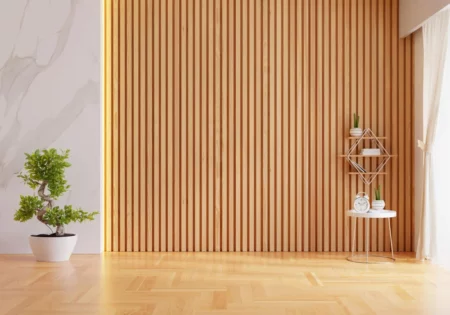 Wainscoting is a classic and elegant way to enhance the visual appeal of your interior walls.
Wainscoting is a classic and elegant way to enhance the visual appeal of your interior walls.
One of the key decisions when embarking on a wainscoting project is selecting the right wood. Different wood species offer varying aesthetics, durability, and maintenance requirements.
Today, we’ll guide you through the process of choosing the perfect wood for your wainscoting project.
1. Consider Your Interior Style
Before choosing wood for wainscoting, consider the style and decor of your home. Different wood species have unique colors, grain patterns, and finishes that can either complement or contrast with your interior design. For a traditional or classic look, woods like oak or cherry work well, while lighter woods like pine or maple can suit a more casual or contemporary style.
2. Durability and Hardness
The durability and hardness of the wood are important factors, especially if your wainscoting will be subject to wear and tear. Hardwoods like oak, cherry, and maple are known for their durability and resistance to dents and scratches, making them ideal for high-traffic areas. Softer woods like pine or cedar are more prone to damage and may be better suited for low-impact spaces.
3. Maintenance Requirements
Consider the maintenance demands of your chosen wood species. Some woods, like cedar, have a natural resistance to decay and insects, making them suitable for humid or outdoor areas. Others may require regular sealing or finishing to maintain their appearance and protect against moisture and stains.
4. Budget Considerations
Your budget is another essential factor when choosing wood for wainscoting. Exotic and rare woods can be expensive, while domestic hardwoods like oak and maple are generally more affordable. Consider not only the cost of the wood itself but also any additional expenses for finishing, staining, or sealing.
5. Sustainability and Environmental Impact
For eco-conscious homeowners, consider the sustainability of the wood species you choose. Look for options certified by organizations like the Forest Stewardship Council (FSC), which promotes responsible forestry practices. Choosing sustainable wood can reduce the environmental impact of your wainscoting project.
6. Compatibility with Wainscoting Styles
Different wainscoting styles, such as raised panels, beadboard, or board-and-batten, may require specific wood types to achieve the desired look. Some styles, like raised panels, benefit from the use of hardwoods for intricate detailing, while beadboard may work well with softer woods due to its simpler design.
By carefully evaluating these factors, you can select the perfect wood species that not only enhances the beauty of your space but also ensures your wainscoting stands the test of time. Whether you prefer the warmth of oak, the richness of cherry, or the simplicity of pine, the right wood can transform your walls into a masterpiece of elegance and charm.
Picture Credit: Freepik



